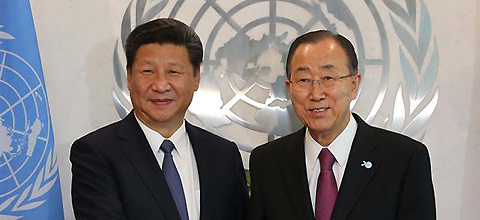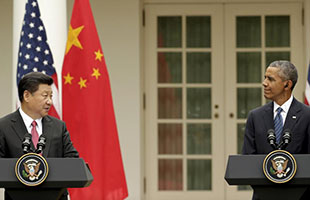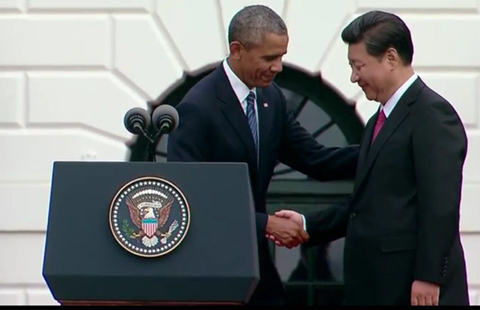Steering around roadblocks
Updated: 2015-09-28 07:46
By Erik Nilsson and Yang Feiyue(China Daily)
|
||||||||
Authorities have streamlined procedures for foreigners to drive into China. Street-smart expats turned road warriors explain why jumping behind the wheel offers jarring yet joyous journeys of discovery in the country. Erik Nilsson and Yang Feiyue report. Erik Nilsson/Yang Feiyue
Richard Webster feared the slick trickling down his neck was blood.
It was.
He lay on his back in the dark, wiggling his appendages one-by-one, before moving his neck, in case it was broken.
It wasn't.
The Briton had tumbled off a two-story farmhouse's roof in a village in Shandong province.
He stumbled away with scrapes and bruises.
Webster chalks up the war wounds to road-rash.
"You have to accept road trips don't go according to plan. That's the point," he explains.
The manic motorist has driven 150,000 kilometers on over a hundred journeys through China, swerving through all but four mainland provinces.
Webster drove through Europe before moving to Beijing nine years go.
"Put me in a car, and I'm happy," Webster says.
"Driving is the best way to see a country."
The government is shifting gears to encourage foreigners to explore China from behind the wheel. It announced at the end of August simplified procedures for foreigners to drive into China via bordering countries.
Foreign motorists will no longer need approval from local public security bureaus and tourism administrations from Oct 1, the start of the weeklong National Day holiday. That's according to a joint notice released by the Public Security and Foreign Affairs ministries, and the China National Tourism Administration.
They'll also no longer need to report half a year in advance to several central government organs, including the CNTA, the General Staff Department and the Ministry of Public Security. These bodies currently must give approval before drivers can start Customs procedures, explains China CYTS Tours' deputy general manager of inbound tourism, Yu Liangbing.
(The rules don't apply to foreign residents.)
"The complex procedures make it virtually impossible for foreign tourists to drive into China," China Tourism Leisure Association secretary-general Wei Xiao'an said after the announcement.
After next week, foreign tourists who plan to drive into China can hire approved travel agencies to handle the procedures 60 days in advance.
The catch is that tourism-visa holders must take along a tour guide.
"That'd probably put me off," Webster says.
That's coming from a guy who picks up every hitchhiker, as a rule.
"Autonomy is the whole point," he says.
Such a requirement would be unthinkable in the West, he points out.
"The new rules will, to some extent, encourage foreigners to drive in China," Yu says.
Foreigners who drive across the border account for 1 percent of CYTS' inbound tourism business.
International-exchange programs propel the current market's main engine, Yu says.
For instance, motorcades of dozens of vintage cars cruise from Paris to China every year.
Most foreigners who take China road trips are from Europe, the United States and Russia, Yu says. CYTS believes neighboring nations offer greater potential.
Webster welcomes the new measures but expects "infinitesimal" impact.
Expenses such as Customs, gas and road tolls mean a dozen days of China travel costs foreigners driving over the border an average of 60,000 yuan ($9,400), Yu says.
US-Ukrainian dual citizen Peter Krasnopolksy's problem wasn't driving into China but out.
The Beijing resident planned to drive through Central Asia from China's Xinjiang Uygur autonomous region last year.
"It was too much red tape," the 36-year-old says.
The Chinese side required 8,000 yuan to process piles of paperwork, plus a deposit of 70 percent of the car's value - with no guarantee of approval.
And Krasnopolksy was already five days late, since the Chinese company he'd paid 3,600 yuan to ship his car to Xinjiang's capital, Urumqi, from Beijing didn't deliver on time. (They compensated him 600 yuan.)
"I got there before my car and had to wait," he says.
He was pulled over for speeding his first day driving in Xinjiang. When he went to pay the fine, he was told his license was revoked because he'd exceeded the 12-point limit.
"I was stranded in a small town," he says.
Wrangling ensued.
"In the end, I didn't have to push my car back to Beijing."
He enjoyed driving a few days before a family emergency forced him to pull an all-nighter, racing from Qinghai province's capital, Xining, to Beijing in about 20 hours.
Krasnopolksy, who has conquered three cross-country routes, believes China road trips are worthwhile, despite occasional roadblocks.
"If you want to see things, you have to get your own wheels," he says.
"In the morning, I don't know exactly where I'll be at night."
He loves veering off-road to discover villages.
Krasnopolksy and Webster once got their cars stuck in a bog in the Inner Mongolia autonomous region. A tractor came to rescue them. It got stuck, too.
Eight hours later, a larger tractor extracted all three vehicles from the muck.
"Still, driving is more convenient," Krasnopolksy says.
"Public transportation isn't that reliable outside main cities."
Webster recalls waiting six hours for a delayed long-distance bus in Sichuan province. When it pulled in, police arrested the driver and told everyone to return the next day.
"That was the moment I decided to actually get my license," he says.
He'll lose that license on June 20, 2028. National law bars people over 70 from driving.
"That's the day I'll leave China."
Contact the writers through erik_nilsson@chinadaily.com.cn
(China Daily 09/28/2015 page22)

 Xi pledges $2 billion to help developing countries
Xi pledges $2 billion to help developing countries-
 Xi calls for equitable, open, all-round development
Xi calls for equitable, open, all-round development 
 First Lady Peng delivers speech in English at UN
First Lady Peng delivers speech in English at UN
 Three Xi-Obama meetings: From casual to black tie
Three Xi-Obama meetings: From casual to black tie
 White House hosts state dinner for President Xi
White House hosts state dinner for President Xi
 First ladies name giant panda cub 'Bei Bei' in Washington
First ladies name giant panda cub 'Bei Bei' in Washington
 Xi, Obama take aim at cybertheft
Xi, Obama take aim at cybertheft
 Obama welcomes President Xi for state visit with 'Nihao'
Obama welcomes President Xi for state visit with 'Nihao'
Most Viewed
Editor's Picks

|

|

|

|

|

|
Today's Top News
Xi pledges $2 billion to help developing countries
Young people from US look forward to Xi's state visit: Survey
US to accept more refugees than planned
Li calls on State-owned firms to tap more global markets
Apple's iOS App Store suffers first major attack
Japan enacts new security laws to overturn postwar pacifism
Court catalogs schools' violent crimes
'Beauty of Beijing's alleys akin to a wise, old person'
US Weekly

|

|







